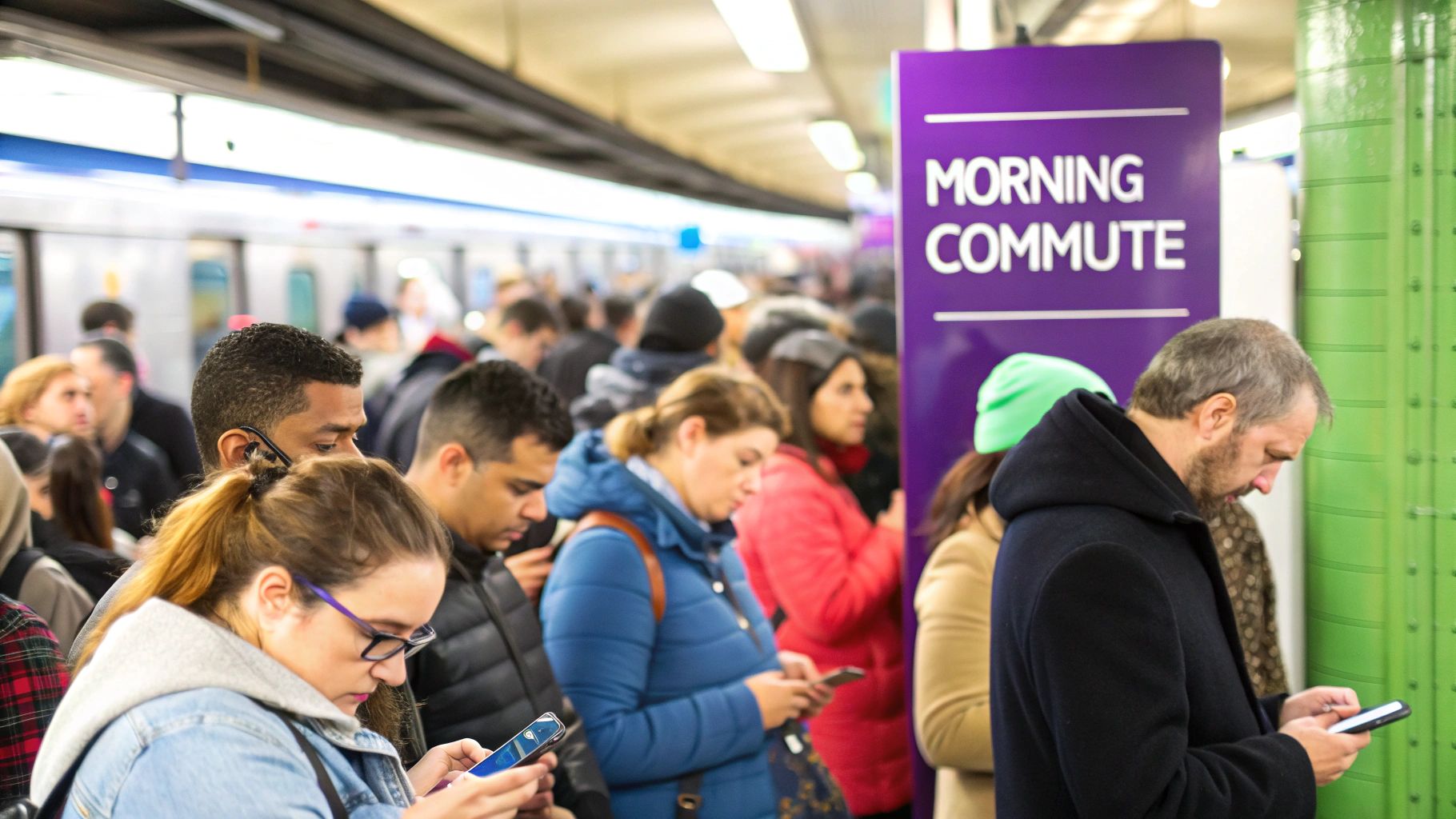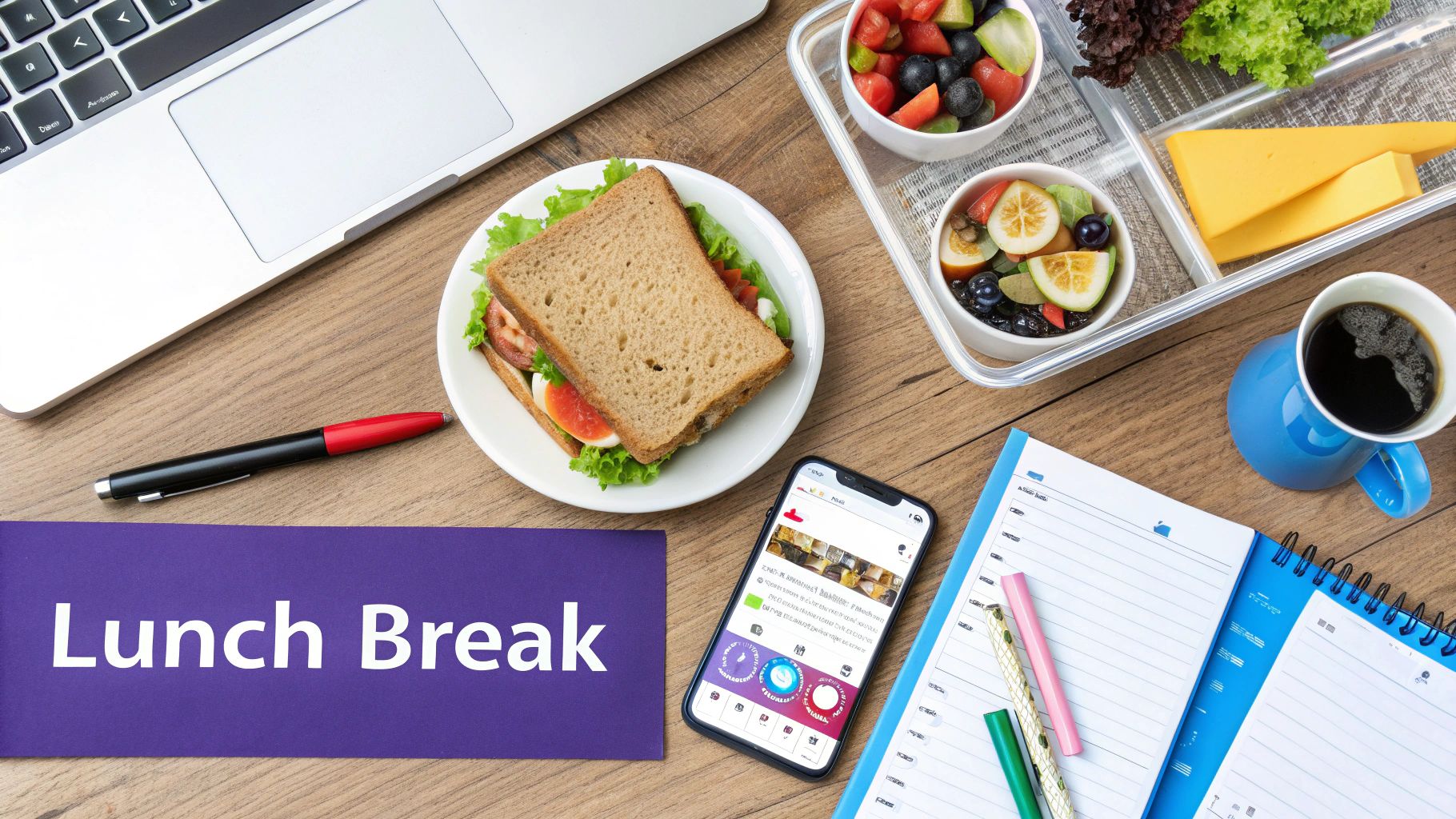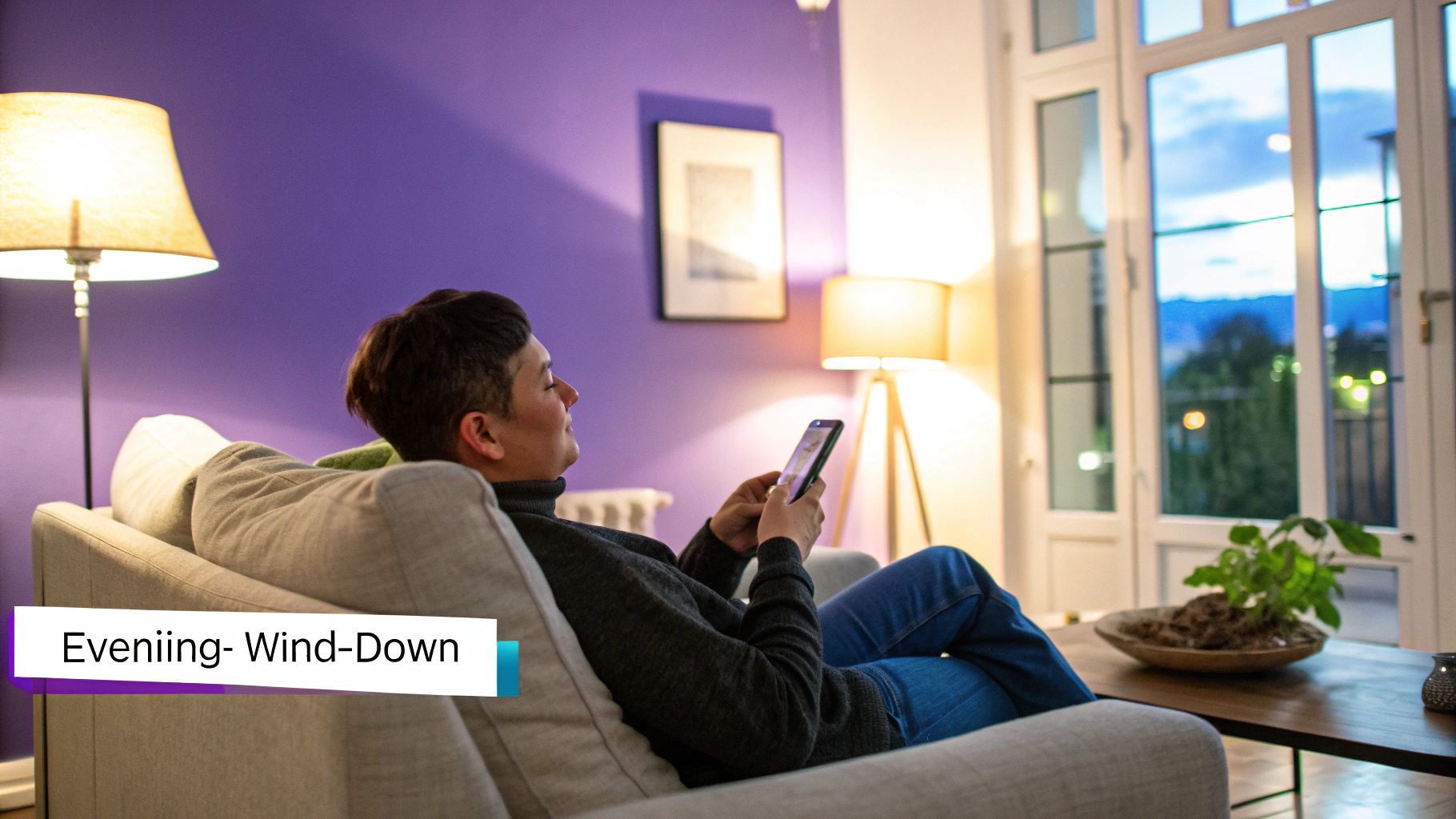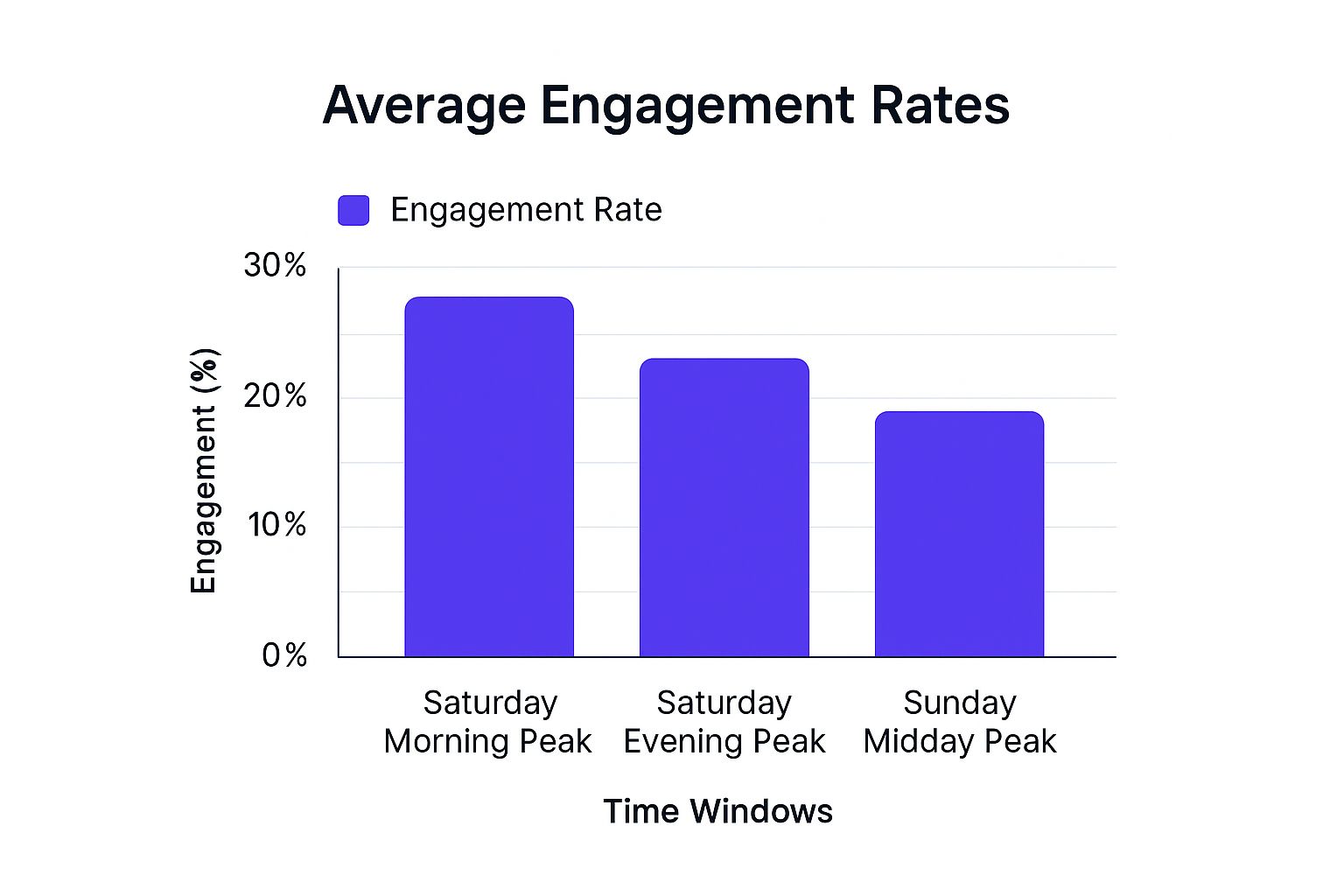Best Time to Post on Social Media in 2025: Top 7 Tips
Find out the best time to post on social media in 2025. Discover 7 strategies to boost your engagement and grow your audience effectively.
Posted by
Unlocking the Secrets of Social Media Timing
Knowing the best time to post on social media is crucial for maximizing your reach and engagement. This comprehensive guide reveals seven powerful strategies to pinpoint the optimal posting times for your audience in 2025. Whether you're a small business owner, a digital marketer, or manage a creative agency's social presence, these actionable insights will elevate your social media game.
This listicle provides specific strategies to help you understand:
- Why timing matters: Discover how posting at the right time connects with active audiences, leading to increased visibility and interaction.
- Strategic time slots: Explore key periods like the weekday morning commute, the lunch break blitz, and the weekend strategic split.
- Platform-specific nuances: Learn how timing strategies differ across various social media platforms.
- Data-driven decision making: Understand how to use analytics to tailor your posting schedule to your specific audience.
We'll cover impactful strategies, including:
- The 9 AM Weekday Window (The Morning Commute Strategy)
- The Tuesday-Thursday Sweet Spot (Mid-Week Momentum)
- The Lunch Break Blitz (12-2 PM Strategy)
- The Evening Wind-Down (7-9 PM Prime Time)
- The Weekend Strategic Split (Saturday Energy vs Sunday Prep)
- The Platform-Specific Timing Matrix
- The Audience-First Analytics Approach
Stop guessing and start strategically scheduling your social media content. Let's unlock the power of perfect timing.
1. The 9 AM Weekday Window (The Morning Commute Strategy)
The 9 AM weekday window capitalizes on a predictable surge in social media activity: the morning commute and the start of the workday. Between 8-10 AM, people are settling into their routines, often checking their phones during commutes, at their desks before diving into work, or during their morning coffee break. This creates a prime opportunity to capture their attention and boost engagement with your content as they begin their daily social media consumption.

This strategy isn't just a theory; it's backed by data. Major companies leverage this window effectively. LinkedIn posts by Microsoft and IBM, for instance, see double the engagement at 9 AM compared to other times. Starbucks regularly uses this window for daily promotional posts, reaching a highly receptive audience. Even news outlets like CNN achieve peak sharing during these morning hours, capitalizing on the morning news cycle. This reinforces the power of the 9 AM window for diverse content types.
Tips for Implementing the 9 AM Weekday Strategy:
- Test and Refine: While 8-10 AM is a general guideline, your specific audience may have slightly different habits. Use analytics to track engagement and pinpoint the optimal time within this window.
- Consistency is Key: Establish a regular posting schedule to reinforce your presence during this peak period. Scheduling tools like Buffer or Hootsuite can be invaluable for maintaining consistent delivery.
- Content Strategy: Focus on content that resonates with a morning mindset. Motivational quotes, industry news updates, or quick tips are often effective choices. Consider what your audience wants to see as they start their day.
- Location Matters: If your target market spans different time zones, adjust your posting schedule accordingly. Monitor commute patterns in your target markets to optimize reach and impact.
Why This Strategy Works:
The 9 AM weekday window offers a unique convergence of high user activity and relatively low competition, compared to later in the day. By strategically posting during this time, you increase the likelihood of your content being seen and engaged with. For businesses looking to boost visibility and reach a wider audience, leveraging the morning commute is a smart move.
If you are focusing on Pinterest, it's good to do additional research to find out platform-specific timings. For example, check out this resource on the best time to post on Pinterest. Understanding the best time to post on social media is crucial for maximizing your reach and engagement, and this applies to visually-driven platforms like Pinterest as well. This morning commute strategy, while effective across many platforms, should be part of a larger content strategy that includes platform-specific optimization.
2. The Tuesday-Thursday Sweet Spot (Mid-Week Momentum)
The Tuesday-Thursday sweet spot capitalizes on predictable mid-week engagement patterns. This strategy avoids the Monday slump and the Friday wind-down, focusing on the peak period of workweek focus and social media activity. Between Tuesday and Thursday, people are fully engaged in their routines, making them more receptive to social media content. This presents a prime opportunity to capture their attention with your most impactful posts.
This strategy is supported by data from various sources. Major brands like Coca-Cola have reported a 40% increase in engagement on posts published Tuesday through Thursday. HubSpot has found that their blog promotion efforts see peak traffic on Wednesdays. Even on visually driven platforms like Instagram, shopping posts perform best on Tuesday and Wednesday, according to Later’s Instagram engagement studies. This demonstrates the effectiveness of the Tuesday-Thursday sweet spot across diverse content types and platforms.
Tips for Implementing the Tuesday-Thursday Strategy:
- Prioritize Content: Schedule your most important content, like product launches or key announcements, for these peak engagement days.
- Thematic Approach: Consider a thematic approach. For example, use Tuesday for educational content and Thursday for promotional posts to cater to different audience needs throughout the week.
- Combine with Time-of-Day Strategies: Maximize your reach by combining this strategy with optimal time-of-day posting schedules. This creates a powerful synergy for increased visibility.
- A/B Test: Refine your approach by A/B testing different mid-week posting schedules. This helps you pinpoint the most effective days and times for your specific audience.
Why This Strategy Works:
The Tuesday-Thursday sweet spot offers a balance between high user engagement and manageable competition. By concentrating your posting efforts during this period, you increase the likelihood of your content resonating with your target audience. This strategy is particularly valuable for businesses aiming to drive conversions and build a strong social media presence. It provides a focused approach to content delivery, maximizing impact during peak engagement periods.
Research from industry leaders like Sprout Social and CoSchedule reinforces the effectiveness of this mid-week momentum strategy. Their annual reports and marketing research consistently highlight the increased engagement rates observed during this period. Understanding the best time to post on social media is crucial for maximizing your reach, and this Tuesday-Thursday approach provides a data-backed framework for achieving optimal results. This strategy, while effective across many platforms, should be part of a larger content strategy that includes platform-specific optimization.
3. The Lunch Break Blitz (12-2 PM Strategy)
The Lunch Break Blitz capitalizes on the midday lull when people often turn to social media for a break from work. Between 12-2 PM, employees are scrolling through their feeds, catching up on news, and seeking a mental refresh. This creates a high-traffic window for content creators to grab attention and boost engagement. This strategy is especially effective for reaching working professionals and driving midday interaction.

This strategy's effectiveness is evident in how major brands leverage it. Food Network, for example, sees a 300% higher engagement rate on lunch-hour recipe posts. Netflix often promotes new shows during this window, driving peak viewing decisions. Retail brands like Target also achieve their highest conversion rates during lunch breaks, as people browse and shop online during their downtime. This demonstrates the power of the lunch break for diverse content and industries.
Tips for Implementing the 12-2 PM Strategy:
- Visual Appeal: Focus on visually appealing content like images and videos for quick consumption. Remember, people are looking for a brief escape during their break.
- Interactive Content: Use polls, quizzes, and other interactive features to encourage immediate engagement. This can be a fun way to capture attention during a short break.
- Light and Entertaining: Post light, entertaining content rather than heavy or complex topics. Think about what provides a quick mental refresh.
- Regional Variations: Consider regional lunch time variations, especially if your target audience spans different time zones. Tailor your posting times accordingly for maximum reach.
Why This Strategy Works:
The 12-2 PM lunch break window presents a valuable opportunity to capture a large, engaged audience. Many are actively looking for a distraction during their workday. By strategically targeting this period, you can increase the visibility of your content and drive higher engagement rates, particularly with a professional audience. It's a smart way to make your content stand out amidst the daily online noise. This strategy, when combined with a comprehensive understanding of the best time to post on social media, can significantly enhance your overall social media performance.
4. The Evening Wind-Down (7-9 PM Prime Time)
The Evening Wind-Down strategy capitalizes on the prime-time hours of 7-9 PM, when many people are relaxing at home after dinner and engaging with social media. This period offers a unique opportunity to connect with your audience on a more personal level as they unwind and browse their feeds. This makes it particularly effective for entertainment, lifestyle, and community-building content that encourages longer engagement.

This strategy is backed by the behavior of major brands and influencers. Netflix, for example, frequently sees peak engagement for series announcements around 8 PM. Fitness influencers often find their highest engagement for evening workout posts during this window. Even news outlets can drive maximum discussion during evening political posts, tapping into the post-workday news consumption habits. This demonstrates the effectiveness of the 7-9 PM window for a variety of content types.
Tips for Implementing the Evening Wind-Down Strategy:
- Focus on Engaging Content: Prioritize content that sparks conversation and encourages interaction. Ask questions, run polls, or share thought-provoking stories to boost engagement.
- Community Interaction: The evening is an ideal time for live Q&As, online events, or interactive games that foster a sense of community among your followers.
- Longer-Form Content: People are more likely to engage with in-depth content during their leisure time. Use this window to share blog posts, videos, or podcasts that offer valuable insights.
- Monitor Audience Habits: While 7-9 PM is a general guideline, analyze your specific audience's evening activity patterns to fine-tune your posting schedule for optimal reach.
Why This Strategy Works:
The Evening Wind-Down leverages the extended time people spend on social media during their leisure hours. This presents an opportunity to capture their attention with engaging content that resonates with their relaxed mindset. Learn more about how to improve social media engagement and maximize the effectiveness of this prime-time window. By understanding the best time to post on social media and tailoring your content strategy accordingly, you can significantly enhance your visibility and connect with your audience on a deeper level. Remember that even though this works well across different platforms, finding out the best time to post on social media on every specific channel you are focused on is still important.
5. The Weekend Strategic Split (Saturday Energy vs Sunday Prep)
The Weekend Strategic Split recognizes the distinct roles Saturday and Sunday play in social media engagement. Saturday vibrates with social energy, focusing on leisure, entertainment, and spontaneous activities. Conversely, Sunday leans towards reflection, planning, and preparing for the week ahead. This shift in mindset presents unique opportunities for targeted content delivery.
This strategy leverages the changing weekend mood. Saturday morning might see fitness brands encouraging workout routines, while Saturday evening becomes prime time for restaurant promotions. Sunday evenings, however, often find users seeking inspiration and motivation for the upcoming week, making it ideal for productivity tips or self-care content. This nuanced approach allows brands to align their messaging with audience behavior.
This strategy isn't just theoretical; data supports it. Travel brands like Airbnb often see increased booking searches and inspiration-seeking behavior on Sunday evenings as users plan their next getaways. Fitness brands report higher engagement on Saturday mornings as users kickstart their weekends with workouts. Food brands dominate Saturday brunch and dinner content, capitalizing on social dining trends. These examples highlight the power of tailoring content to specific weekend dayparts.
Tips for Implementing the Weekend Strategic Split:
- Saturday Focus: Prioritize fun, social, and lifestyle content. Think vibrant visuals, engaging stories, and interactive polls related to weekend activities.
- Sunday Focus: Share inspirational, planning, and preparation-focused content. Motivational quotes, goal-setting tips, and resources for the week ahead resonate well.
- Timing is Key: Utilize Saturday mornings for active lifestyle posts and Sunday evenings for motivational or reflective content.
- Analyze and Adapt: Track engagement metrics to understand what resonates best with your audience on each day and adjust your strategy accordingly.
Why This Strategy Works:
The Weekend Strategic Split leverages the best time to post on social media by acknowledging the distinct user behaviors on Saturdays and Sundays. By aligning your content with these shifting mindsets, you can capture attention and boost engagement. This approach allows for more targeted messaging, resulting in greater relevance and impact. Understanding these nuances is crucial for maximizing your weekend social media performance. This targeted approach allows you to connect with your audience on a deeper level by acknowledging their evolving weekend needs and interests, contributing to a more effective overall social media strategy.
6. The Platform-Specific Timing Matrix
The Platform-Specific Timing Matrix recognizes that each social media platform has its own rhythm. User behavior, algorithm preferences, and content consumption patterns vary significantly across platforms, demanding customized timing strategies for optimal performance. This approach moves beyond general time slots and dives into the nuances of each platform.
This strategy is not a one-size-fits-all solution; it requires understanding the unique characteristics of each platform. For example, LinkedIn, a professional networking platform, sees high engagement for B2B posts at 8 AM, 12 PM, and 5 PM on weekdays, aligning with typical work schedules. TikTok, on the other hand, thrives on short-form video content, with peak engagement occurring between 6-10 AM and 7-9 PM, especially Tuesday-Thursday. Visually-driven platforms like Pinterest often see higher saves and click-through rates for evening posts (8-11 PM) when users are more relaxed and browsing for inspiration. This illustrates how user behavior dictates the best time to post on social media for each specific platform.
The following bar chart visualizes average engagement rate differences across different times:

As the chart demonstrates, Saturday morning enjoys the highest average engagement at 30%, followed by Saturday evening and Sunday midday. This underscores the importance of considering weekend posting strategies as part of a Platform-Specific Timing Matrix.
Tips for Implementing the Platform-Specific Timing Matrix:
- Use Native Analytics: Leverage the analytics dashboards provided by each platform (e.g., LinkedIn Analytics, TikTok Analytics, Pinterest Analytics) to understand your specific audience's behavior and identify peak engagement times. This data provides invaluable insights for tailoring your posting schedule.
- Invest in Social Media Management Tools: Comprehensive tools like Hootsuite or Later offer features like "Best Time to Post" suggestions based on historical data and platform algorithms, streamlining the scheduling process across multiple platforms. Learn more about scheduling and other aspects of the Platform-Specific Timing Matrix by checking out this helpful resource: Learn more about....
- Test and Adjust: Don't assume that initial findings are set in stone. Regularly test and adjust your timing strategies, ideally quarterly, to adapt to changing user behavior and algorithm updates.
- Consider Audience Overlap: If your target audience uses multiple platforms, analyze potential overlap and coordinate posting times to maximize reach and avoid overwhelming specific segments.
Why This Strategy Works:
The Platform-Specific Timing Matrix acknowledges the fundamental differences between social media platforms. By tailoring your posting schedule to the unique characteristics of each platform, you significantly increase the likelihood of reaching your target audience when they are most active and receptive. This targeted approach optimizes engagement, improves visibility, and ultimately drives better results.
7. The Audience-First Analytics Approach
The Audience-First Analytics Approach prioritizes understanding your specific audience's behavior over relying on generalized industry averages for the best time to post on social media. This data-driven strategy leverages platform analytics, audience insights, and A/B testing to determine personalized optimal posting times based on when your unique followers are most active and engaged. It moves beyond guesswork and generic advice to create a tailored posting schedule that maximizes reach and impact.
Brands like Glossier exemplify this approach. They use customer behavior data to pinpoint when their beauty-focused audience is most engaged with their content. Similarly, Patagonia, targeting outdoor enthusiasts, analyzed their audience data and found peak engagement surprisingly early at 6 AM. Even local restaurants can use location-based analytics to optimize their social media posting schedules for neighborhood dining patterns. These examples demonstrate the power of tailoring your approach to your specific audience.
Tips for Implementing the Audience-First Analytics Approach:
- Use Platform Insights: Dive into the native analytics provided by each social media platform. Identify the days and times when your followers are most active online. This is your starting point for building a data-driven schedule.
- A/B Test Posting Times: Experiment with posting similar content at different times within the identified peak activity windows. This allows you to fine-tune your schedule and pinpoint the most effective posting times for your specific audience.
- Track Meaningful Engagement: Go beyond vanity metrics like likes and comments. Track engagement rates, click-throughs, and shares to get a more comprehensive picture of how your content is performing. Learn more about measuring social media success to get a deeper understanding of valuable metrics. Learn more about measuring social media success
- Consider Audience Lifestyle: Think about your audience's typical day. Are they early risers? Do they check social media during their lunch break? Understanding their lifestyle and work patterns can inform your posting strategy.
Why This Strategy Works:
The Audience-First Analytics Approach recognizes that every audience is unique. What works for one business may not work for another. By focusing on your own data, you can create a highly effective posting schedule that resonates with your specific followers. This personalized approach leads to increased visibility, engagement, and ultimately, better results. To maximize your impact on Pinterest, it's crucial to understand platform-specific timing. For instance, our research indicates that knowing the best time to pin on Pinterest can significantly improve engagement.
This strategy, popularized by data-driven marketing experts like Rand Fishkin and adopted by leading social media analytics companies and agencies, is becoming increasingly essential for maximizing your social media ROI.
Best Time to Post: 7-Point Strategy Comparison
| Strategy | Implementation Complexity 🔄 | Resource Requirements ⚡ | Expected Outcomes 📊 | Ideal Use Cases 💡 | Key Advantages ⭐ |
|---|---|---|---|---|---|
| The 9 AM Weekday Window | Medium - requires consistent timing and timezone adjustments | Moderate - scheduling tools recommended | High morning engagement and open rates | B2B, professional content, morning traffic | High visibility, catches alert audiences, lower competition |
| The Tuesday-Thursday Sweet Spot | Medium - strategic content planning needed | Moderate - content and possible ad spend | 20-40% higher engagement mid-week | B2B & B2C announcements, launches | Statistically proven peak engagement, better algorithm favor |
| The Lunch Break Blitz (12-2 PM) | Medium - precise timing needed due to short window | Moderate - engaging, visually appealing content | Spikes in midday engagement and immediate actions | Food, lifestyle, entertainment, shopping | Captures dedicated social media break, strong for quick interactions |
| The Evening Wind-Down (7-9 PM) | Medium-High - requires content for longer sessions and varied demographics | Moderate-High - live, video content recommended | Deep engagement, higher comments and shares | Entertainment, lifestyle, community-building | Long session durations, best for video and live streams |
| The Weekend Strategic Split | Medium - distinct strategies for Sat & Sun | Moderate - diverse weekend content creation | Higher personal engagement with tailored focus | Lifestyle, B2C brands, social & inspirational | Lower business competition, tailored for weekend audience |
| The Platform-Specific Timing Matrix | High - complex multi-platform scheduling and analysis | High - requires multiple tools and frequent adjustments | Maximized engagement per platform | Brands active on multiple social networks | Custom, platform-specific optimization, better ROI |
| The Audience-First Analytics Approach | High - requires extensive data analysis and ongoing monitoring | High - analytics, A/B testing and tools needed | Most accurate and continuously optimized engagement | Brands with sizeable followers tracking unique audience | Personalized timing, adapts to audience behavior, highest engagement |
Mastering Your Social Media Timing Strategy
Finding the best time to post on social media isn't about following a rigid schedule. It's about understanding the rhythms of your specific audience and adapting your strategy accordingly. This article explored seven key approaches to help you pinpoint those optimal posting windows. From leveraging the morning commute and lunch break blitzes to understanding the nuances of weekend engagement, each strategy offers a unique perspective on maximizing your reach and impact.
Key Takeaways for Optimized Posting
Let's recap the core principles for identifying the best time to post on social media:
- Audience Analysis is Paramount: Your target audience's online behavior dictates your ideal posting schedule. Don't rely on generic best practices; dig into your analytics to understand their unique patterns.
- Experimentation is Key: Testing different posting times is crucial. What works for one business might not work for another. Continuously analyze your results and refine your strategy.
- Consistency Fuels Growth: Even with perfect timing, sporadic posting hinders growth. Establish a consistent posting schedule to build audience anticipation and maintain engagement.
- Platform Specifics Matter: Each platform has its own peak usage times. Tailor your posting schedule to match the platform's unique characteristics and your audience's behavior on that platform.
Putting Your Knowledge into Action
Now that you're equipped with these strategies, the next step is to implement them. Start by analyzing your current social media performance. When analyzing performance, consider tracking these key social media metrics for success in 2025. This resource from Lumeo can guide you on the essential metrics to monitor for a comprehensive understanding of your social media impact. Then, experiment with the timing strategies outlined in this article. Track your results and adjust your posting schedule based on the data.
The Power of Strategic Timing
Mastering your social media timing strategy is about more than just increasing likes and shares. It's about connecting with your audience when they're most receptive to your message. It's about maximizing your visibility and driving meaningful engagement. By strategically timing your posts, you can boost brand awareness, generate leads, and ultimately achieve your business objectives. Remember, consistency and data-driven decision-making are key to unlocking your full social media potential.
Ready to streamline your social media scheduling and optimize your posting times? EndorseFlow helps you plan, schedule, and analyze your social media content, so you can focus on creating engaging posts and connecting with your audience at the perfect moment. Visit EndorseFlow to learn more and start maximizing your social media ROI.